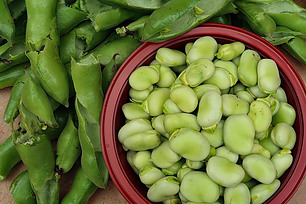Broad beans growing should start as early as possible. This early sowing allows the plant to develop very well before the attack of aphids and rust.
Broad beans sowing go in the first half of the year. Because it is a tall plant, it is difficult for other plants to grow in its shade in the spring. It is picked from the plant at the end of June or the beginning of July, and any summer-autumn vegetables can be planted behind it. Sow late carrots, turnips, kohlrabi or transplant summer lettuce, radicchio, endive, kohlrabi, cabbage, broccoli, cauliflower, collard greens, and leafy or Brussels sprouts.
Do Successful Broad Beans Growing to Depend on Quick Sowing?
Every year I want to sow broad beans as soon as possible, often already at the beginning of February. This seems to be the key to success and why growing broad beans in my garden is successful. Aphids and rust attack it in any case, so it is good to finish the crop as soon as possible.
I recommend that broad beans be sown on a fruit day before the end of February.
Broad Beans Growing and Resistance to Cold
Worries about the cold and the cold ground are unnecessary. The soil can freeze after sowing, but that’s no problem because broad bean seeds are very resistant to cold and germinate at shallow temperatures. The sprout sprouts, the root begins to develop rapidly, and the green part of the plant is waiting for suitable conditions.
As you can see, sowing broad beans is easy, but I would like to point out that quality seed is also important in addition to early sowing. Homegrown seed is definitely the best choice! Don’t have homegrown seeds? In order to grow beans and possibly grow your own seeds, I recommend you choose the best genetics.
Further Cultivation of Broad Beans
There is very little work with broad beans until they are harvested. Since the inter-row distances are large, weeding is very simple.
I do this with the help of a swing hoe or with a hardened hollow hoe. I cut the mini weeds once every 14 days and let them dry on the bed.
Support
It is recommended to support the broad beans so that it does not hang on the paths, making it difficult to walk around the garden.
I do this by driving shepherd’s pegs along the entire bed length, on each side, and tying them with string.
Harvesting
Broad beans can already be used in the very early stage of the pods. In this way, it is useful similarly to green beans.
Later, it is used as a fresh grain, which cooks much faster than mature grain. Therefore, waiting for the grain to ripen fully for the crop is unnecessary. We harvest when the grains are still fresh (yellowish-green in color) and of the largest possible size.
For later use, it is best to freeze it. If you want to store broad beans in a dry state, say in a jar, dry the fresh broad beans first.
Broad Bean Cultivation Begins With the Production of Home-Grown Seeds!
How to grow seeds? Simple. Broad beans leave on the bed until the plants begin to dry. They may become weak; rust, lice, etc., will attack them. No worries.
You can pluck the whole plants and hang them with the pods somewhere in the shade, in an airy place, for a couple of days to dry completely. The grains are then removed from the pods and stored in a glass in a dark, dry place.
Conclusion
Thank you for your attention! I hope I have helped you with the above note. If you like the article, please pass it on to your gardening friends and acquaintances.
Be beautiful, and let it grow!
